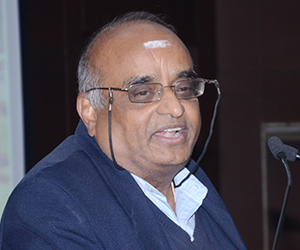A New Regime of Taxation
Goods and Services Tax (GST) is a broad-based, comprehensive, single indirect tax which will be levied concurrently on goods and services across India. It will replace most of the Central and State indirect taxes such as Value added Tax (VAT), Excise Duty. Service Tax, Central Sales Tax, Additional Customs Duty and Special Additional Duty of Customs. GST will be levied at every stage of the production and distribution chains by giving the benefit of Input Tax Credit (ITC) of the tax remitted at previous stages; thereby treating the entire country as one market. Introduction of GST in India is perceived to be the most ambitious initiative in the arena of indirect tax reforms. It would change the Indian tax structure and pave the way for modernization of tax administration.
The GST Bill has recently been approved by both the houses of Parliament and is in the process of being endorsed by the State assemblies. It needs endorsement from fifty percent or 15 of the assemblies before it receives Presidential assent. Meanwhile, a company had been incorporated on March 28, 2013, for the primary purpose of providing information technology (IT) infrastructure and services to the Central and State Governments, tax payers and other stakeholders in their implementation of the GST. This GST Network (GSTN) is a Section 25 (that is, ‘not for profit’), non-government, private limited company. The Government of India holds 24.5% equity in GSTN, while all the States of the Indian Union, including the National Capital Territories (NCT) of Delhi and Pondicherry, and the Empowered Committee of State Finance Ministers (EC), together hold another 24.5%. Balance 51% equity is with non-government financial institutions. The Authorised Capital of the company is Rs.10 crore (http://gstn.org/).
As politicians argue fiercely and persistently over the nitty-gritty of this long-awaited and ambitious indirect tax reform that promises to make India a common market, the organisation responsible for creating and managing the complex IT backbone that will make GST operational, the GSTN has moved, without fanfare, into glitzy new headquarters at Worldmark I, which is a part of a vast commercial multi-storey chain owned by Sunil Mittal-promoted Bharti Realty. The 30,000 square foot space that GSTN occupies on its fourth floor couldn't be a bigger contrast to its cramped quarters in Hotel Janpath in central Delhi, its temporary base of operations since it was incorporated in March 2013. In this new headquarters, there is little to suggest that this Section 25 company is a government organisation with the Centre and States holding 24.5 per cent stakes each, the rest being held by a clutch of banks and private sector institutions.
With its carefully delineated spaces, clean lines and such stylish trimmings as jazzily coloured ‘breakout rooms’, a canteen where it is compulsory for all staffers, chairman downward, to eat, and a ‘ladies' room’ for expectant mothers to rest, this could readily be mistaken for the office of a PE/VC-funded IT start-up run by a 30-something entrepreneur. The ambience is not accidental either. As GSTN Chairman Navin Kumar had told Business Standard a year ago, "The idea is to create an entity that is under the strategic control of the Government but will have the flexibility of the private sector. The Government has given GSTN Rs 320 crore for funding companies to purchase hardware needed for the system and are going to give some more". As if to highlight the difference, a racy blue, red and green logo, created by the National Institute of Design, adorns a banner at the airy reception area as well as the visiting cards and stationary. These are only the outward signs of the solid, if low-profile, progress the organisation has made to get the IT infrastructure ready for this long-delayed tax becoming a reality. A world away from the din of political rhetoric over rates, the shape of the law, minimum applicable thresholds and, most recently, the prospect of a 1 per cent inter-state tax, GSTN has already made some robust progress (http://www.business-standard.com/article/economy-policy/gst-s-network-effect-116012801411_1.html).
Asked about the Government's initiative to connect products and SME customers with start-ups to GST platform, Prakash Kumar, the CEO, said that a few start-up companies have already begun to approach the Government and suggest innovative ideas of developing applications to help them connect their products and SME customers to the GST platform. "A couple of start-ups came to me, and one of them I met was zapped by their innovation. Yes, we need very innovative start-ups to add value to the GST platform. We need at least 10 to 12 such applications developed by start-ups," he added (http://www.business-standard.com/article/pti-stories/computerisation-of-commercial-tax-depts-completed-gstn-116030201096_1.html).
Background
It was the speech of Budget, 2010-11 when the then Finance Minister – Shri Pranab Mukherjee, announced the setting up of a “Technical Advisory Group for Unique Projects” (TAGUP). TAGUP was set up under the chairmanship of Shri Nandan Nilekani to address the technological and system related issues in respect of five projects including the GST. It was the report of TAGUP submitted in January 2011 which suggested that the task of handling the IT related issues in respect of these five projects should be handed over to a class of institutions called ‘National Information Utilities’ (NIU). It was also suggested that the NIU would be the reporting authority to the Government and would award contracts to vendors in the market for specialized IT related services.
Later on, in July 2010, Shri Pranab Mukherjee, with the assent of the EC, set up an Empowered Group on IT Infrastructure for GST (EG-IT) which was also headed by Shri Nandan Nilekani. It was dedicated group which was entrusted the job of looking into technological needs for the implementation of the GST. It is worth mentioning here that TAGUP was responsible for making recommendations in respect of the five projects already identified at the time of announcing the 2010-11 Budget, while EG-IT was responsible to work on GST network only. Based on the reports of these two groups, it was decided that:-
- NIU for GSTN should be incorporated as a non-government, Section 25 Private Limited Company, registered under the Companies Act, 1956.
- Government’s share in equity should be 49% - 24.5% each of the Centre and the
States. - Total private ownership should be 51%.
- No single private entity should hold more than 10% of equity.
Thus, basically, the GSTN is to be in the hands of private sector with 51% of shares (http://taxguru.in/goods-and-service-tax/gstn-privatization-justified.html).
Objectives of GSTN
GSTN has been set-up with the following objectives to act as a pass-through interface for the dealing agencies:-
- Integration of the common GST Portal with the existing tax administration systems of the Central and State Governments and other stakeholders.
- To provide common PAN based registration, to enable returns filing and payment processing for all States on a shared platform.
- Facilitation, implementation and setting standards for providing services to the Taxpayer, the State Governments and other stake holders through common GST Portal.
- To build efficient and convenient interfaces with tax payers to increase tax Compliance.
- To carry out research, study best practices and provide training to the stakeholders.
The select committee of Parliament (Rajya Sabha) has suggested, “The GSTN is the comprehensive back-end infrastructure network for the management of tax data and reporting of the GST. The Committee noted that the Non-Government shareholding in GSTN is dominated by private banks, and this is not desirable. It recommended that the Non-Government Institutional shareholding be limited to public sector banks and financial institutions”.(http://taxguru.in/goods-and-service-tax/gst-network-gstn-implementation-gst.html)
The objections raised by the Committee are quite obvious and these simply cannot be ignored in the light of the fact that GSTN would be a database of almost every significant transaction being carried out in the national economy. GSTN’s work therefore is of strategic importance to the country and the firm would be a repository of a lot of sensitive data on business entities across the country.
Main Concerns
Everything relating to GSTN was not so agitating until it was revealed that 51% of the shareholding of GSTN would lie in the hands of the private sector which would then be privy to a storehouse of a large amount of critical information. Majority private shareholding of such a company implies that critical information related to about 6 million taxpayers would be in the hands of private players. Further, the GSTN has been incorporated as a not-for- profit Section 25 Company whereas the private sector works only for profit; it is quite unusual for this sector to invest on public welfare. This very fact induces a serious question as to why should the private sector be investing in a not-for-profit Company; certainly, some kinds of incentives or interests must be associated with such investment. It would not be wrong therefore to assume that there may be some attraction of larger non-monetary incentives. Or rather, it may be said that access to such critical data relating to the taxpayers itself is the biggest advantage associated with the investment. This threat alone is a major cause of concern for those who argue against privatization of GSTN.
Taxation system of any country is always considered to be the safest when it is under control of the state. Handing over the control of such sensitive data in the hands of the private sector is in itself the biggest threat to the economy. How shall the government ensure the economic security of nation if such data is misused by the private entities to get benefits out of it. Indeed, going by the above arguments, it can be safely opined that such critical information relating to taxpayers must not be given in the hands of such private entities. It must be noted that concerns had been raised even by the Central Board of the EC regarding ownership and security of such sensitive and confidential data in the dominion of the private sector owned GSTN. But it was later decided not to question the decision of the EC before proceeding with the registration of GSTN, thus ignoring the fact that CBEC is the most important stakeholder in this transitive tax revolution. What induces more questions is that GSTN, being a private company, shall be out of the ambit of CAG. Considering the above arguments, it would not be wrong to question the security and confidentiality of the critical taxpayers’ database. What then could be the possible reasons behind private equity in GSTN? Is it indicating towards the Government’s inability to efficiently manage the biggest tax revolution of the nation, or is the government trying to shed off its responsibilities? Why does the government want to keep GSTN out of the ambit of CAG?
The currently proposed structure of GSTN is based upon the recommendations of TAGUP and EG-IT which had given their reports after a number of rounds of discussions, whereas the EC has suggested that concerns regarding the data security should be addressed by incorporating related provisions in the Articles of Association of the company entrusted with GSTN. The EC has also clarified that the Chairman of GSTN would be appointed by Government. Also, as stated earlier, no single private entity will own more than 10% of equity while Centre and State will own 24.5% equity each. Thus, ultimate control will vest with Government anyways. Further, a monitoring committee headed by Revenue Secretary was also proposed to be constituted to review the working of GSTN. Other suggestions are for the GSTN to be bound to follow the internationally accepted security and safety measures of protecting the data leakage and for appointment of a Chief Information Security Officer on deputation from the Government to look into the matters related to information security. Finally, the EC has clarified that the audits of GSTN would be conducted by independent auditors, including the professional personnel designated to carry out technology reviews and offering suggestions thereupon. Even if the above stated justifications in respect of information protection mechanism were spelt out by the EC while finalizing the model of GSTN, these remain the least discussed issues in the relevant fora (http://taxguru.in/goods-and-service-tax/gstn-privatization-justified.html)
Some may argue that since the Passport system and data mining for SEBI are run by the TCS, and Income Tax is assisted by Infosys, what could be wrong if the GSTN is in private hands. However, there is a lot of difference between projects and outsourced activities undertaken by private companies and entire departments run by privately owned entities. From that point of view the concerns of the BJP leader Dr. Subramanian Swamy seems justified. Dr Swamy has urged Prime Minister Narendra Modi to have full Government control over the GSTN company since it was not advisable to bring private firms in the administration of tax-related matters. He has pointed out that besides the Centre and the States owning 49 per cent stakes, the rest 51 per cent of shares were controlled by private banks and National Stock Exchanges’ subsidiary, the Strategic Investment Corporation, with 10% each held by HDFC Bank, ICICI Bank, HDFC Ltd and the NSE, 11% shares being held by LIC Housing Finance Limited, where the Bank of Muscat and Abu Dhabi Investment Corporation also have shares. Being such a large shareholder, this means that, “HDFC and ICICI will be the bankers of public money collected through taxes”, he said, citing a recent transfer of Rs. 4,000 crore by GSTN to develop software. Thus reiterating the issues discussed above, Dr. Swamy argues that programming work and electronic management of a scheme that requires constitutional amendment to implement, should be handled by Government itself ( http://www.dailypioneer.com/nation/swamy-writes-to-pm-against-gstn-bats-for-full-govt-control.html).
Conclusion
It might be worthwhile to put together a policy or a guideline paper on appropriate management of such sensitive Government projects and initiatives, including rules regarding ‘conflict of interest’. Right now, very few seem to know where the actual lines are. So it ends up being a free for all. If I recall correctly; there were allegations that Sam Pitroda, during his tenure at C-Dot, telecom department etc. had staffed many companies with relatives who then secured government contracts. Similar is the case with a large number of World Bank assigned projects with the Finance Ministry, which are contracted by small companies floated by parties having insider knowledge. The average citizen has no idea where the lines were crossed and where they weren't. Short of a getting a law degree oneself, I can't even see how he is supposed to know where the lines are. I think it would be a huge social service to tell the nation a-priori what the lines are, rather than drawing them retrospectively and institute mechanisms to avoid conflicts of interest as well as sacrificing interests of the state for the benefit of few (http://indiatoday.intoday.in/story/serious-allegations-against-c-dot-chief-sam-pitroda/1/315050.html, http://www.newsindiatimes.com/pitroda-denies-knowledge-of-arrested-businessmans-shady-deals).
It is important that more discussion takes place regarding the GSTN. It would be most appropriate if the Finance Ministry comes out with due elaborations and tuen the GSTN into a fully government controlled company which can be audited by CAG.
Published Date: 27th August 2016, Image Source: http://insuranceagencyaccountants.com
(Disclaimer: The views and opinions expressed in this article are those of the author and do not necessarily reflect the official policy or position of the Vivekananda International Foundation)









Post new comment